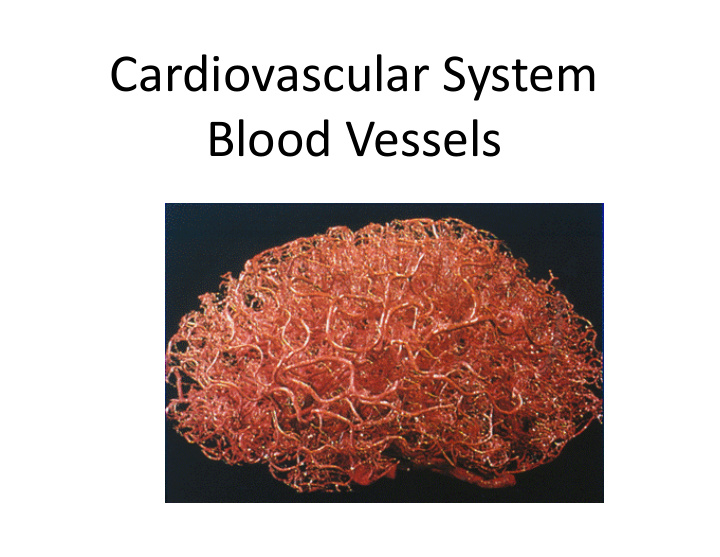



Cardiovascular System Blood Vessels
Structure of Blood Vessels • The three layers (tunics) – Tunica intima – composed of simple squamous epithelium – Tunica media – sheets of smooth muscle • Contraction – vasoconstriction • Relaxation – vasodilation – Tunica externa (adventitia) – composed of connective tissue • Large vessels contain a vasa vasorum • Lumen – central blood ‐ filled space of a vessel
Structure of Arteries, Veins, and Capillaries
Types of Blood Vessels • Arteries – carry blood away from the heart – Types: elastic (conducting), muscular (distributing), and arterioles • Capillaries – smallest blood vessels – The site of exchange of molecules between blood and tissue fluid • Veins – carry blood toward the heart
Types of Arteries • Elastic arteries – the largest arteries – Diameters range from 2.5 cm to 1 cm – Includes the aorta and its major branches – Sometimes called conducting arteries – High elastin content dampens surge of blood pressure – Thicker tunica intima • Due to thicker subendothelial layer
Types of Arteries • Muscular (distributing) arteries – Lie distal to elastic arteries – Diameters range from 1 cm to 0.3 mm – Includes most of the named arteries – Tunica media is thick – Unique features • Internal and external elastic laminae
Types of Arteries • Arterioles – Smallest arteries – Diameters range from 0.3 mm to 10 µm – Larger arterioles possess all three tunics – Diameter of arterioles controlled by: • Local factors in the tissues • Sympathetic tone
Capillaries • Smallest blood vessels – Diameter from 8–10 µm • Red blood cells pass through single file – Site ‐ specific functions of capillaries • In the lungs – oxygen enters blood, carbon dioxide leaves • In the small intestines – receive digested nutrients • In endocrine glands – pick up hormones • In the kidneys – removal of nitrogenous wastes • In the liver – removal of toxins, nutrients for metabolic events…
Capillary Beds • Network of capillaries running through tissues • Control of blood in capillary beds – Precapillary sphincters – regulate the flow of blood to tissues • Tissues & Structures with little or no blood flow – Tendons and ligaments – poorly vascularized – Epithelia and cartilage – avascular • Receive nutrients from nearby connective tissues
Capillary Beds
Capillary Permeabillity • Endothelial cells – held together by tight junctions and desmosomes • Intercellular clefts – gaps of unjoined membrane – Small molecules can enter and exit • Three types of capillaries – Continuous – most common – Fenestrated – have pores – Sinusoids – wide porous capillary found in some organs
Cross Section of Continuous Capillaries
Cross Section of Fenestrated Capillaries
Sinusoids • Wide, leaky capillaries found in some organs – Usually fenestrated – Intercellular clefts are wide open • Occur in bone marrow and spleen – Sinusoids have a large diameter and twisted course
Routes of Capillary Permeability • Four routes into and out of capillaries – Direct diffusion – Through intercellular clefts – Through cytoplasmic vesicles – Through fenestrations
Low Permeability Capillaries • Blood ‐ brain barrier – Capillaries have complete tight junctions – No intercellular clefts are present – Vital molecules pass through • Highly selective transport mechanisms – Not a barrier against • Oxygen, carbon dioxide, and some anesthetics – Other blood barrier?
Veins • Conduct blood from capillaries toward the heart • Blood pressure is much lower than in arteries • Smallest veins – called venules – Diameters from 8–100 µm – Smallest venules – called postcapillary venules • Venules join to form veins • Tunica externa is the thickest tunic in veins
Mechanisms to Counteract Low Venous Pressure Valves in some veins • Particularly in limbs – Skeletal muscle • pump Muscles press – against thin ‐ walled veins Respiratory pump • Causes changes in – thoracic vs. abdominal pressure
Vascular Anastomoses • Vessels interconnect to form vascular anastomoses • Organs receive blood from more than one arterial source • Neighboring arteries form arterial anastomoses – Provide collateral channels • Veins anastomose more frequently than arteries
Circulation Routes • Pulmonary • Systemic – Arteries – Capillaries – Veins • Special Venous Routes
Pulmonary Circulation
Systemic Circulation • Systemic Arteries – Carry oxygenated blood away from the heart – Aorta – largest artery in the body • Capillaries – point of exchange • Systemic Veins – Carry deoxygenated blood towards the heart – Venae Cavae – the largest of the arteries that enter into the right atrium
Flow Chart – Main Systemic Arteries
Flow Chart – Main Veins of Systemic Circulation Figure 19.25
The Basic Scheme of the Hepatic Portal System Figure 19.22
Veins of the Hepatic Portal System Figure 19.23
Blood Vessels Throughout Life • Fetal Circulation – All major vessels in place by month 3 of development – Differences between fetal and postnatal circulation • Fetus must supply blood to the placenta • Very little blood is sent through the pulmonary circuit
Vessels to and from the Placenta • Umbilical vessels run in the umbilical cord – Paired umbilical arteries – Unpaired umbilical vein • Ductus venosus • Ligamentum teres • Ligamentum venosum • Medial umbilical ligaments
Shunts Away from the Pulmonary Circuit • Foramen ovale • Ductus arteriosus
Fetal and Newborn Circulation Compared Figure 19.26b
Recommend
More recommend